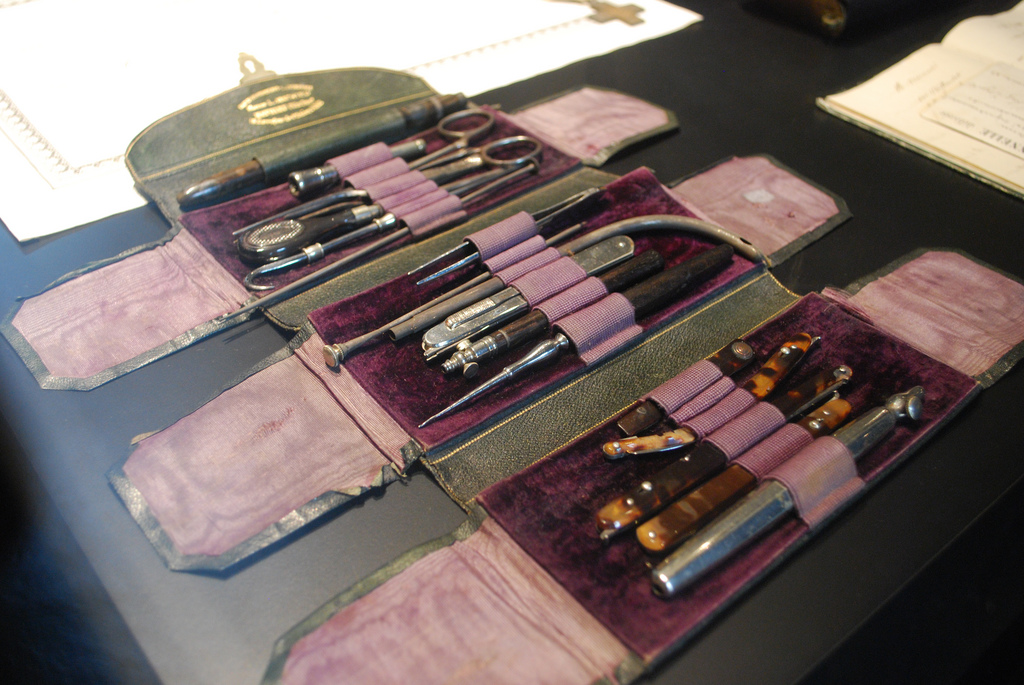Surgery is a nasty business. Depending on the procedure, surgeons need to cut bone, pierce tissue, and slice apart flesh. To accomplish these terrifying-but-necessary jobs, surgeons use all manner of scary implements. Let’s take a look at the most frightening ones.
Bone Cutter
Bone cutters, colloquially known as bone saws, are so intimidating that a hulking, brutish wrestler was named “Bonesaw” in a Spider Man film, and the name fit. The purpose of bone cutters is self-explanatory; they cut through bones, allowing surgeons to move and rearrange bones or access something behind the bone such as a brain. These tools range from basic, manual hacksaws all the way up to reciprocating, buzzsaw-style slicers. According to the National Institutes of Health, surgeons even work with ultrasonic bone cutters. That’s right—saws that cut through bone using high-pitched sound.
Rib Spreader
Like the bone cutter, the rib spreader’s name is brutal in its honesty. This tool is used in thoracic surgery, which generally involves the chest cavity. And “cavity” is a fitting word to use when talking about rib spreaders, because this tool certainly makes a chest more cavernous. The New York Times‘ Carl Zimmer writes that traditional rib spreaders can cause broken ribs, crushed nerves, and torn ligaments. Not surprisingly, medical professionals are hoping that a kinder alternative emerges.
Dental Drill
Dentists have their own terrifying surgical tool. Dental drills make that high-pitched whirring sound that keeps many people away from the dentists’ office. These are used in root canals, cavity repair, and in the removal of decayed tooth material. Dental drills can operate at 400,000 revolutions per minute (RPM). By comparison, car engines operate at roughly one percent of that.
Needles
Used for everything from anesthetic to vaccines, needles are the bane of many children and more than a few adults. In surgery, the most benevolent of these are used to help close wounds—they’re typically necessary for sutures. But other, scarier needles exist for other surgery applications. For instance, according to a guide published by Virginia Commonwealth University, the ideal bone marrow biopsy needle is six inches in length. That’s half a foot, and it essentially stabs straight into bone.
Surgical Stapler
Sometimes, instead of a suture, surgeons use staples to close up a wound. At a glance, surgical staplers aren’t much different from your average office stapler in function; they usually take disposable staples and punch them into things. The only difference is that surgical staplers penetrate organs instead of paper. Two seemingly uncomfortable areas that commonly get the staple treatment are the lungs and bowels.
Scalpel
Scalpels might not be as visually scary as the other items on this list, but their ferocity comes from their purpose: they exist to slice through flesh. These tools are so sharp they’re even dangerous to those who wield them. The Centers for Disease Control and Prevention estimates that hospital health-care workers are injured 385,000 times per year by sharp tools, including scalpels. Even when they’re not used in surgery scalpels can be scary.
The process of cutting people up and putting them back together is a brutal process, and the implements involved are a fairly intimidating part of that process. For all the good it does, surgery involves many frightening tools. Just be glad they’re wielded by professionals.
Byline
Bobby Potter is a freelancer based in Sioux Falls, South Dakota. Bobby enjoys contributing articles on medical science, the medical profession, medical education, medical gadgetry and other related areas; those considering the medical field should take a peek at cnacertification-training.com.
Image credit goes to kevingessner.

